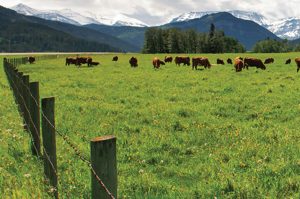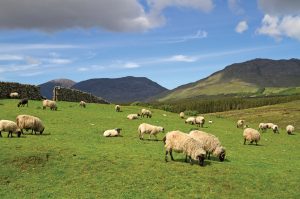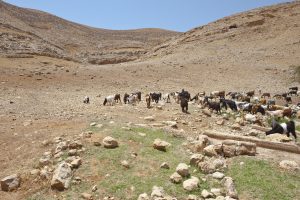 Livestock’s Role in Feeding the World Sustainably
Livestock’s Role in Feeding the World Sustainably
Livestock (such as cattle, chickens, pigs and sheep) play an important role in our society, economy and environment.
 A Role to Play:
A Role to Play:
- Food, Fibre, Fuel and By-Products: Livestock provide meat, milk and eggs as well as millions of by-products such as clothing, fuel and ingredients in items such as lipstick and car tires.
- Changing Diets: There is an increasing demand for meat protein as diets change around the world. In some countries meat is over consumed and in others it is sought after to combat malnutrition.
- Land Use: Livestock such as cattle, sheep and goats can use land that we are unable to grow crops on. Only 10% of Earth’s land is ideal for growing crops; yet, we can raise livestock on areas that are too rocky and hilly for example and produce a high quality, nutrient-rich protein source.
- Ecosystem: Livestock use natural resources so it is vital they are raised with best practices, innovation and improved efficiencies to grow more with less water, land, feed, antibiotics and waste.
“[E]ven the most modern post-industrial societies remain critically reliant on animals for food and nutrition security,” FAO Director-General Jose Graziano da Silva said the livestock sector is of “enduring importance” and “can play a key role in improving the lives of millions.”1
 Did you Know?
Did you Know?
- “The introduction of advanced genetics, feeding systems, animal health controls and other technologies over the past four decades allowed industrialized countries to reduce their overall land requirements for livestock by 20 percent while doubling meat production.
- Wider adoption of existing best practices and technologies in feeding, health and husbandry, and manure management – as well as greater use of improved technologies – could help the global livestock sector cut its GHG emissions by as much as 30 percent.
- Currently, livestock production employs at least 1.3 billion people worldwide.
- About 600 million of the world’s poorest households keep livestock as an essential source of income.
- Between 2000 and 2014, global production of meat rose by 39 percent; milk production increased by 38 percent.
- Meat production is projected to increase another 19% by 2030, and milk production another 33% in the same period.
- Livestock production accounts for 40 percent agriculture output in developed countries and 20 percent of agricultural output in developing countries
- Animals remain an important source of power. In India, for instance, two-thirds of the country’s cultivated area is ploughed using animal energy, and 14 million animal-drawn carts haul up to 15 percent of the country’s total freight”.2
 Livestock Considerations in the Sustainability Debate:
Livestock Considerations in the Sustainability Debate:
“Realizing the potential of the livestock sector to end hunger and malnutrition
The livestock sector can contribute in multiple ways to ending hunger and all forms of malnutrition. They include: increasing the direct consumption of nutritious animal-source foods; helping to generate income; supporting the creation of employment; and generating fiscal revenue and earning foreign exchange. The sector must, however, overcome some new, interconnected challenges. Increased demand for livestock products will add to existing pressure on ecosystems; livestock producers will face greater competition for resources so that while productivity should increase, it will likely do so more slowly. Furthermore, the ongoing transformation of the sector’s market structure may hinder small producers and poor consumers from benefiting from economic growth and productivity improvements.
Balancing animal-source food intake to increase children’s cognitive development, school attendance and performance
Animal-source foods (ASFs) provide highquality and readily digested protein, are rich in energy and provide readily absorbable and bioavailable micronutrients. These nutrients are more easily obtained from ASFs than from plant-based foods. Providing adequate amounts of foods of animal origin in the diets of schoolchildren can add much-needed diversity and sustain and improve cognitive performance, micronutrient status, growth, physical activity, academic achievement, and appropriate response to vaccines while also fending off opportunistic microbes.
Increasing water-use efficiency in livestock production to address water scarcity
Agriculture withdraws approximately 70 percent of all available freshwater, and livestock production uses roughly 30 percent of that. To meet rising demand for animal products, the livestock sector is currently making growing use of agricultural water, thus increasing competition with other human and crop-agriculture water needs. Given the very substantial water footprint of livestock production, improving water use efficiency and policy guidance throughout the production system is important in ensuring access to safe water sources and sanitation.
Turning animal manure into clean, renewable energy
Around 17 percent of the global population lacks access to electricity, and 38 percent is without clean cooking facilities. Almost 80 percent of these people live in rural areas. Converting livestock manure into biogas could make a major domestic renewable fuel source available to more than a billion people, giving them access to affordable, reliable, and sustainable energy. This would be of particular importance in subSaharan Africa and Southern Asia, where rural villages often lack direct connections to national electricity grids, locking them in poverty and underdevelopment.
Producing more with less, while balancing consumption, and reducing losses
As consumption of animal products is expected to increase, the livestock sector needs to produce more with less. Unsustainable production and consumption not only contribute to inefficient use of resources but are also the source of lost economic opportunities, environmental damage, and poverty and health problems. Adoption of best practices can lead to large gains in natural resource-use efficiency. Rebalancing diets to reach nutritional recommendations can also have significant impact on natural resource use and GHG emissions. Efficiency can further be improved by reducing food waste and losses along supply chains. Because improvements are needed along the whole life cycle of products, this goal requires the involvement of various stakeholders, including consumers, policymakers, retailers and industry representatives. However, adapting and enforcing new technologies in local environments, and instituting supporting policies and infrastructure to encourage adoption, will be the greater challenge
Enhancing the provision of ecosystem services through sustainable grassland management and improvements in feed-use efficiency
Across the globe, natural resources are deteriorating, ecosystems are under stress and biological diversity is being lost. Land used for grazing and feed production has major environmental impacts. While the livestock sector plays a part in biodiversity reduction, land degradation and deforestation, it also provides invaluable services that protect, restore and promote sustainable use of terrestrial ecosystems, combat desertification, reverse land degradation and halt biodiversity erosion. Whether the environmental effects of the livestock sector are detrimental or positive depends on the livestock production and management system. Livestock production can be crucial in, for example, supporting sustainable rangeland management, preserving wildlife, and enhancing soil fertility and nutrient cycling.
Combating climate change and its impacts through improving livestock resource-use efficiency
The relationship between livestock and climate change works two ways. On the one hand, livestock make a significant contribution to climate change. On the other hand, climate change affects livestock production. Efficiency is key to both reducing emissions and building resilience. A number of mitigation and adaptation options are available to improve natural resource-use efficiency while also increasing soil carbon and recycling nutrients from within food chains. Their implementation requires a transfer of technology and knowledge, together with the right incentives and a conducive regulatory framework. However, measures that go beyond the farm gate are also required, including institutional changes, disaster risk management, and social safety nets.”1
Read More: http://www.fao.org/3/CA1177EN/ca1177en.pdf
Source:
1. FAO. 2018. World Livestock: Transforming the livestock sector through the Sustainable Development Goals – In brief.
Rome. 12 pp. Licence: CC BY-NC-SA 3.0 IGO. http://www.fao.org/3/CA1177EN/ca1177en.pdf
2. http://www.fao.org/news/story/en/item/1157729/icode/


